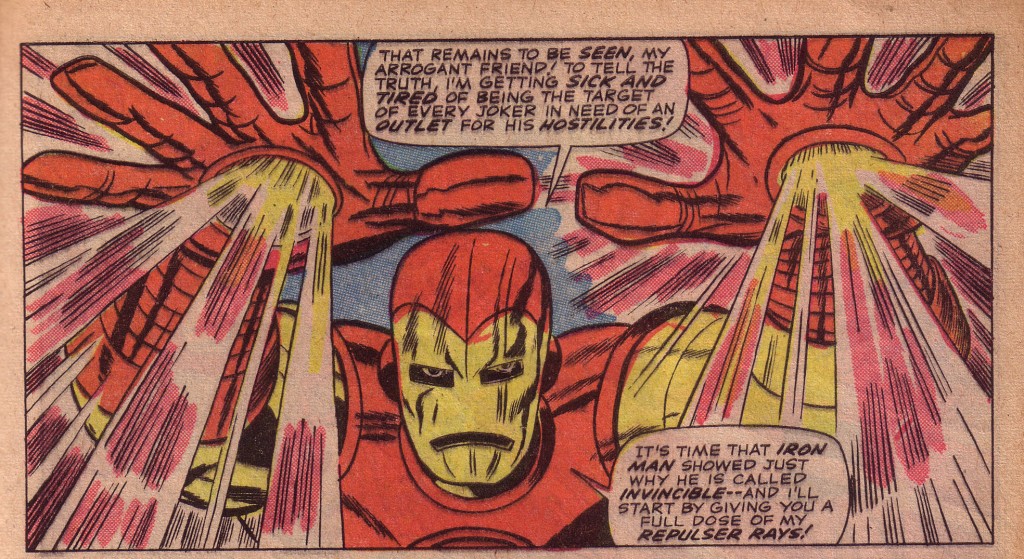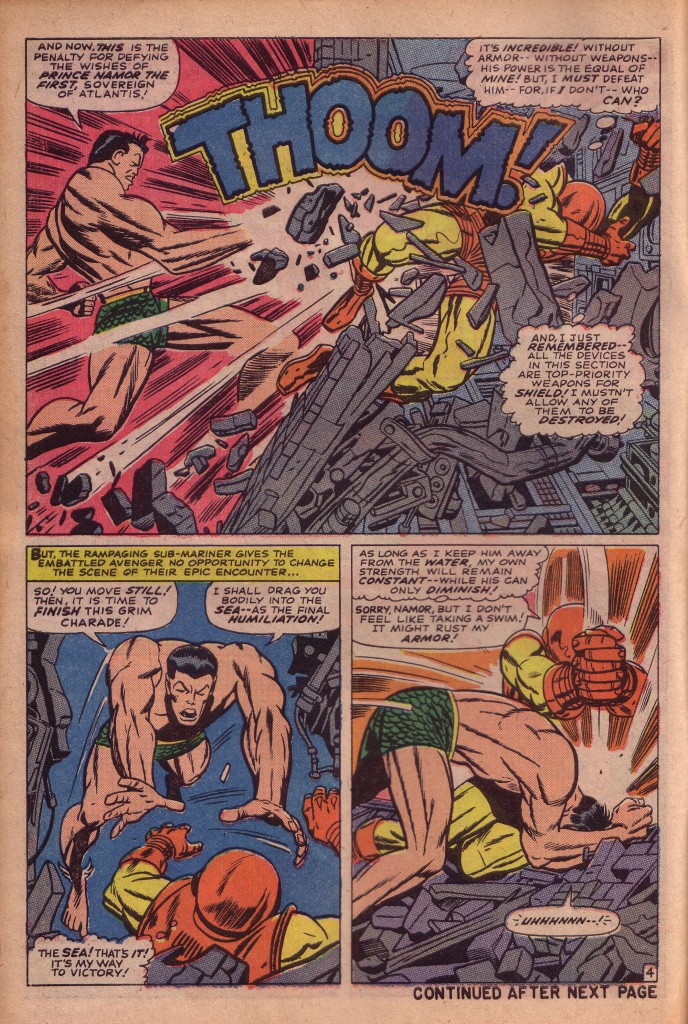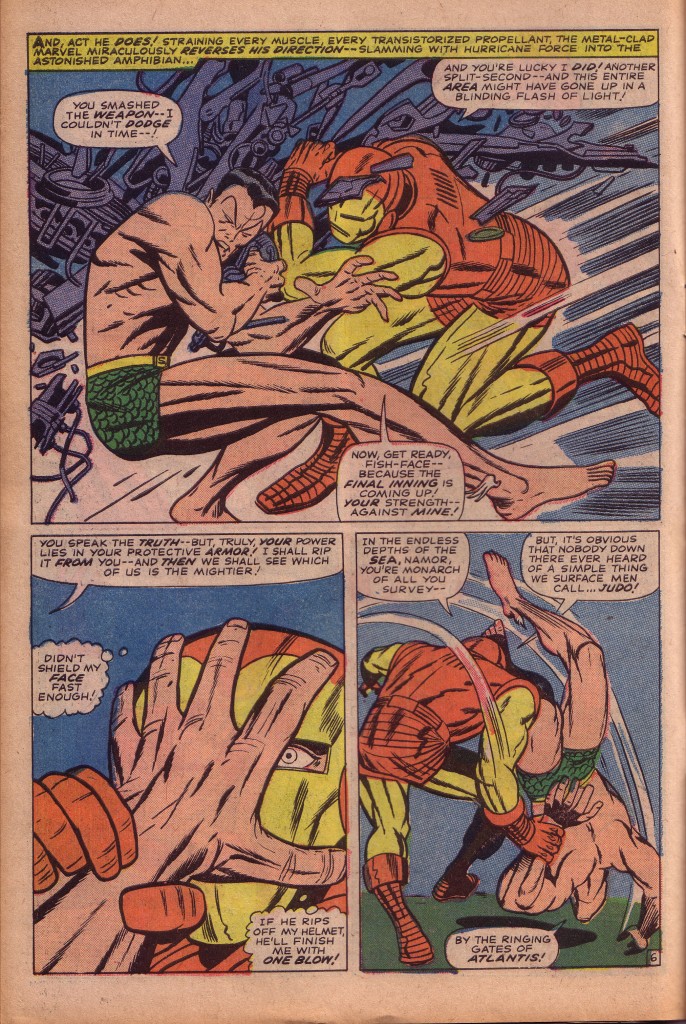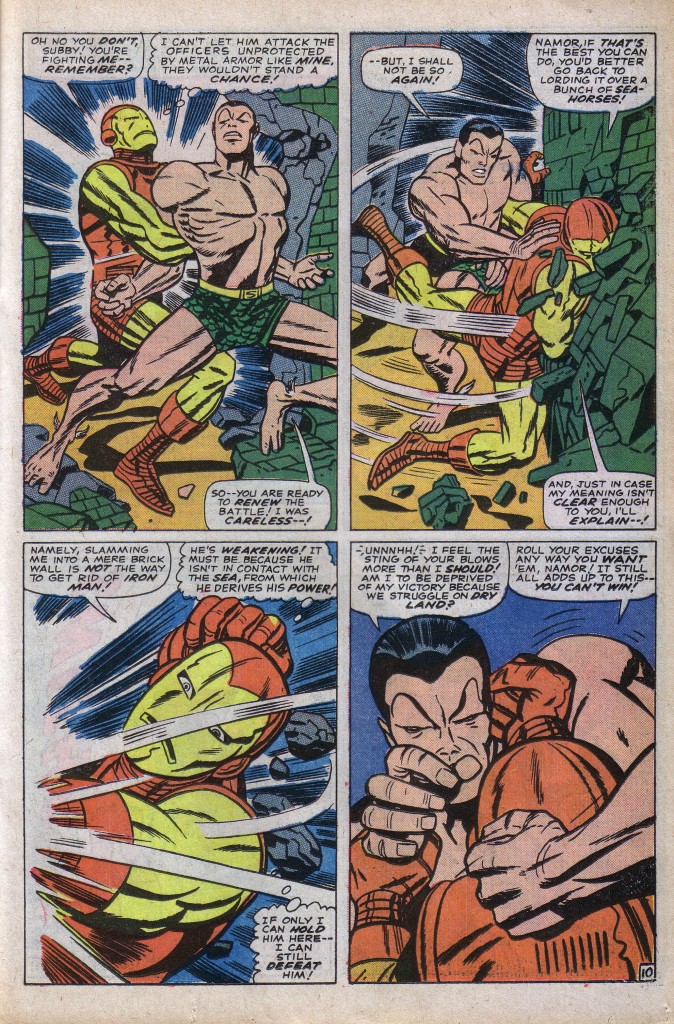One of the most explosive high energy comic books that I’ve ever seen reportedly came about when Jack Kirby was asked to fill in for ailing artist Gene Colan. Indeed, the first few pages of the Sub-Mariner story in Tales to Astonish #82 are drawn by Colan in his lively and finely etched illustrative style, but when Kirby takes over on the third page, it is as if the stopper is blown clean off the bottle. Although veteran Kirby inker, Dick Ayers gives the story a beautifully subtle embellishment, using more delicate line work than usual to tie the disparity of styles together, the contrast is still a bit jarring. Colan’s last panel on page two shows Iron Man at bottom left delivering an uppercut to the Sub-Mariner. Iron Man’s right arm tentatively leads the reader’s eye to the right and the top of the next page, where Kirby obligingly gives us his opening salvo, a staggering blast from Iron Man’s repulser rays.
Kirby’s signature use of outstretched palms thrust forward in forced perspective announces his sudden presence in no uncertain terms. We can’t know if Kirby has seen the preceding page, but the ever professional artist aligns the trajectory of the rays coming from Iron Man’s right hand with the visual sweep of the composition in the page on the opposite left bottom panel, giving the story greater continuity.
Kirby’s first page is relatively subdued, seemingly in consideration of the abrupt artistic switch. His panels are smaller and do not overawe. It is on page four, his second page that Kirby floors Iron Man and us with a devastating blow from Namor.
The Sub-Mariner’s right bicep bulges with pent-up energy. The lines that slash down his triceps to the crook of his elbow join those lines that shoot up his forearm and end in a blinding white impact explosion. Kirby renders force in his most expressive manner with lines that emphasize the power and direction of Namor’s blow, as well as those that reinforce its impact. The perfectly placed “Thoom” sound effect slams Iron Man to the wall at the right of the panel, and the smashed machinery below his figure rams him upward, as well as directing the eye downward to Namor’s leaping figure in panel two.
The fight continues apace. Namor rips a huge electro-magnetic projection device from its moorings, firing powerful bolts of energy at his foe. Iron Man hurls himself at the Sub-Mariner, smashing the piece of equipment to bits. Kirby is utilizing spacious three panel pages to showcase his action sequences, and the first panel is always the most dynamic.
Here on page 6 , the figures relationships to each other are extraordinarily complex and wonderful to behold. Apparently reversing the standard left to right orientation, Kirby shows us Iron Man crashing into Namor from the right side. The reason for this is that it emphasizes The Sub-Mariner’s attitude. Namor’s pose in this panel is completely defensive. He is crossing his arms, turning his head away and shutting his eyes to protect himself from both the impact and the flying shards of steel. To repeat, although the movement seemingly originates in Iron Man rushing from the right, the composition is actually the Big-O, one that we have discussed previously. That means that the eye is continually moving in a circle, and Kirby creates focal points for the eye to linger on before moving. Namor’s jackknifed body is a wedge from which all the energy of the panel is emitted. The apex of that force is Namor’s gluteus, from where the visual bolts of the explosion emanate. Entering the panel at the upper left, the eye drops like a plum line down the Sub-Mariner’s back to his butt, and the spotted slashes of black of Namor’s abdomen, forearms and thigh muscles blast outward and to the right. Even Namor’s splayed fingers emphasize this fanning out explosive thrust. The curve of Iron Man’s back brings us back around to Namor again in the circular motion that characterizes the Big-O.
Ingeniously, Kirby repeats the splayed hand motif in the second panel, which reinforces the panel above it. The curve of the fingers also creates an arc to the motion of the judo maneuver in the third panel.
This issue is a titanic slug-fest and is filled with astounding action moments. Before the fight breaks off, there is one more sequence I’d like to spotlight. Here on page #10, Iron Man seizes Namor, apparently locking his arms and rendering him helpless. The Sub-Mariner easily frees himself.
In the first panel, Namor’s left leg protrudes towards the second frame. What Kirby draws here is physiologically impossible, but makes perfect compositional sense. The sea monarch’s left hand and the upper and lower portions of that leg emphasize the sweeping motion of the second panel as Namor whips Iron Man around, smashing him face first into a wall. Again, legs play a major compositional role, as Iron Man’s left foot brings our roving eye to the third panel below left. The battle ends abruptly in a stalemate, as the Sub-Mariner suddenly quits the field in pursuit of another enemy.
This issue is a one of a kind Kirby action wonder, which I can’t say enough about, so I leave off here. Nobody does this sort of thing better than the King.
All samples from Tales to Astonish #82, Stan Lee, Jack Kirby, Dick Ayers

